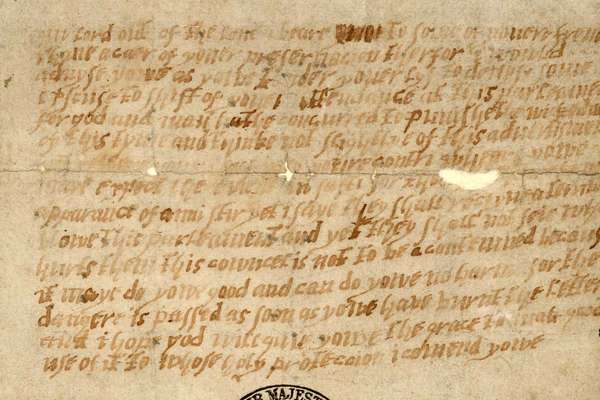In pictures
Treason
First defined by the 1352 Treason Act, treason was the worst crime you could commit. Records held at the National Archives detail centuries of treasonous plots and traitors, described in statute rolls, legal records, and state papers.
Declaration of Guy Fawkes, with his signature

- Date
- 17 November 1605
- Catalogue reference
- SP 14/216
Guy Fawkes, one of the conspirators in the Gunpowder Plot, was captured in the early hours of the morning of 5 November 1605. He was interrogated several times in the following months, up to his trial and execution in January 1606.
When captured, Fawkes gave his name as John Johnson, and his initial confessions are signed under that false name. Eventually though, his true name was discovered. This declaration, made on 17 November 1605, is signed 'Guido Fawkes'.
At the end of this confession, Fawkes confirms that Sir Everard Digby, Ambrose Rookwood, Francis Tresham, John Grant, and Robert Wyntour were among the main conspirators.
Journal of the trial of Charles I

- Date
- 1649
- Catalogue reference
- SP 16/517
On 30 January 1649, King Charles I was executed for treason, for levying war against and causing the bloodshed of his own subjects during the civil wars of the 1640s.
Shortly after his execution, this manuscript journal was drawn up to record this historic event. It describes the proceedings of the trial, starting with the creation of the High Court of Justice.
This entry, the first folio of this journal, begins with the Act of Parliament that established the High Court of Justice that would try and sentence the king.
US Declaration of Independence

- Date
- 1776
- Catalogue reference
- EXT 9/1
On 4 July 1776 the thirteen United States of America declared independence from the rule of Great Britain and King George III.
In the Declaration, George III is accused of being a tyrant and a traitor to the American people, and of levying war against his own American subjects.
The original declaration was signed and handwritten, but to ensure that the message of independence was distributed across the colonies, the printer John Dunlap made printed copies. This is one of these printed copies, called a Dunlap Broadside.
Pike heads seized during the Cato Street conspiracy

- Date
- 1820
- Catalogue reference
- TS 11/208
The Cato Street Conspiracy was a plot to murder all the British cabinet ministers and the Prime Minister in 1820, while they were supposed to be having a dinner. However, the dinner was fake, and the conspirators entrapped.
These pike heads, which would have been attached to wooden spears when used, were produced at their trial as evidence of their violent and treasonous plans, part of a stockpile of weapons.
The defence claimed that the police spy George Edwards was keenly involved in the procurement and distributions of arms. Thirteen were found guilty of High Treason and on 1 May 1820 five men were hanged and posthumously beheaded. Their heads were held aloft to the crowd, and their names proclaimed as traitors.
Diary of William Joyce, alias ‘Lord Haw-Haw’

- Date
- 1945
- Catalogue reference
- KV 2/250
In 1946, William Joyce was the last person to be executed for treason in the United Kingdom. He was charged with levying war against King George VI by travelling to Germany in the early months of the Second World War and broadcasting pro-Nazi propaganda to British radio audiences.
Featured article
Record revealed
The Monteagle Letter

Is this the most famous anonymous letter in British history? Perhaps it should be. Without it, the Gunpowder Plot might have succeeded.